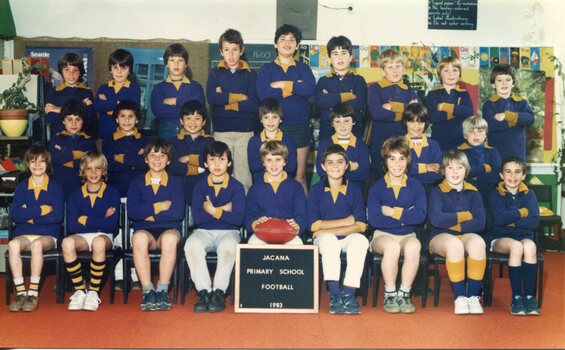Historical information
Jacana Primary School, founded in 1959 amid the rapid suburban expansion of Melbourne’s northern corridor, emerged during a time of significant public investment in education and infrastructure. Located near Broadmeadows, the school served a growing population of working-class families, many of whom were newly arrived migrants. This diverse community shaped the school’s inclusive and multicultural character.
By the early 1980s, Jacana Primary had become more than just a place of learning—it was a central hub for community life. Team sports, particularly football, played a vital role in the daily rhythm of the school. Football’s growing popularity, especially among migrant communities, made it a natural fit for fostering teamwork, physical fitness, and social connection among students.
The 1983 football team photograph captures this vibrant period in the school’s history. It reflects the importance of extracurricular activities in promoting school spirit, cultural exchange, and community engagement. The image also embodies the values of public education at the time: equity, participation, and the celebration of diversity. As part of Jacana Primary’s visual archive, it stands as a lasting record of how schools helped shape local identity and cohesion during a transformative era in Melbourne’s suburban development.
Significance
This photograph of Jacana Primary School’s 1983 football team is a significant historical record that reflects the social and cultural dynamics of Melbourne’s northern suburbs during a period of rapid suburban growth and demographic change. Taken at a time when schools were central to community life, the image captures the role of sport, particularly football, fostering inclusion, teamwork, and school pride.
The photograph is especially meaningful within the context of Jacana’s diverse student population, shaped by post-war migration and working-class settlement. Soccer, a sport embraced by many migrant communities, served as a unifying activity that transcended language and cultural barriers. It provided students with a sense of belonging and identity, while also promoting physical health and social development.
As part of Jacana Primary School’s visual archive, this image contributes to a broader understanding of how public education supported multicultural integration and community cohesion in late 20th-century Victoria. It stands as a testament to the enduring value of extracurricular programs in shaping student experiences and strengthening the social fabric of local neighbourhoods.
Physical description
A colour photograph on matte finish photo paper.
Inscriptions & markings
PH-5431(blue label) Top left Corner
Manufactures mark; Fujicolor/ Paper

